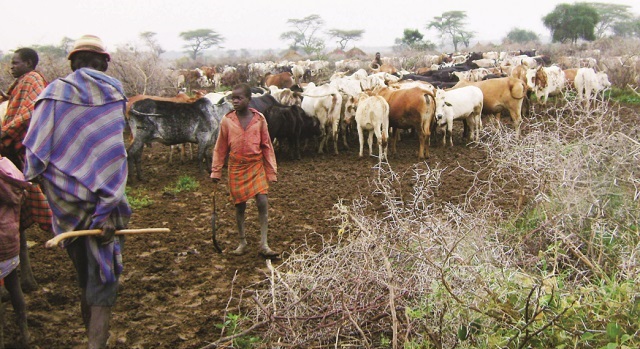
Politicians and local businessmen biggest profiteers
Kampala, Uganda | RONALD MUSOKE | Growing demand for cattle across eastern Africa is slowly turning cattle rustling, a traditional practice among pastoralists, into one of the region’s most brutal transnational organized crime syndicates, according to a study from the Institute for Security Studies.
In their December 2019 paper titled,“Vanishing herds: Cattle rustling in East Africa and the Horn,” the researchers from ENACT (Enhancing Africa’s response to transnational organized crime), say cattle raiding in the region is no longer a cultural practice, but a form of organized crime committed by international criminal networks.
ENACT is an EU-funded project implemented by the Institute for Security Studies and INTERPOL in collaboration with the Global Initiative against Transnational Organized Crime. The researchers say most recent incidents suggest that the practice has become a complex transnational organized crime because of the use of small arms and light weapons and the involvement of actors whose interests are purely economic.
In the past, the researchers say, cattle rustling was widely practiced among several East African pastoral communities including; the Maasai, Samburu, Turkana, Borana, Orma, Karimojong, Dodoth, Teso, Pokot, Nandi and Somali as a way of restocking herds after severe drought or when a disease had killed their livestock. In other instances, the practice enabled suitors (young warriors) to acquire cattle to pay the bride price required in order to marry.
“But (now) crime and capitalism have commercialized this practice, making it a significant economic threat,” said Duncan Omondi Gumba, the lead researcher and ENACT regional organized crime observatory coordinator for East Africa.
Historically, areas affected by cattle rustling have been characterized by inadequately resourced security, little government presence and general underdevelopment. These areas include; the fragile border areas of eastern Ethiopia/Somaliland, southern Somalia/northeastern Kenya, western Ethiopia/eastern Sudan, southern Ethiopia/northern Kenya, and northern Tanzania/southern Kenya as well as southern South Sudan/northwestern Kenya/northern Uganda and eastern Uganda/western Kenya.
Multiple factors such as the role of politicians, the involvement of businessmen supplying meat to towns and cities as well as unemployment, especially among the youth, are some of the elements that have modified the traditional face of cattle rustling.
Citing the latest statistics and reports, the researchers show that cattle rustling has evolved in both methods and extent. It is now being practiced for commercial reasons and through criminal networks that cross communal and international borders. The researchers say the practice is now embedded in the wider cattle trade business enabled by government corruption, with state officials often turning a blind eye or collaborating with criminals.
Cattle not contraband
Cattle are not illegal commodities like drugs and contraband goods that may trigger an alert when they are transported, whether on foot or in trucks, the report notes. Similarly, there are no laws in East Africa and the Horn forbidding transportation of cattle within a country’s territorial borders. As a result, stolen cattle are transported in trucks through networked organized syndicates.
The animals are moved in similar ways across international borders in small numbers to avoid suspicion, or they are disguised to conceal their real colour. In these instances, documents are falsified to indicate that the cattle have followed a genuine transaction process necessary for export.
Buoyed by sophisticated communication tools like WhatsApp and market information, the criminals are targeting small-scale pastoralists who are the backbone of the regional beef industry in the process threatening the livelihoods of the pastoralists.
According to the ENACT study, the proliferation of small arms on the continent at the end of the Cold War resulted in the emergence of markets in the region where cattle were bartered for guns and bullets and bullets traded for cattle, resulting in a lethal symbiosis with catastrophic consequences.
Death of rustlers, security forces
But, as cattle rustling has intensified, the number of deaths among rustlers, security forces and affected populations has also increased. Countries like Uganda, have in the past responded, in two ways, by using largely indiscriminate force and incentivized disarmament initiatives.
At the beginning of the millennium, a ruthless disarmament drive led by the Uganda People’s Defence Forces (UPDF) saw many Karimojong warriors handover thousands of assault rifles. But the Karimojong cried foul claiming that disarmament left them exposed to attacks by their colleagues in Kenya, who are still armed; the main threat in the region.
The government remained adamant and eradicated guns in the region. Many observers say that disarmament has reaped dividends or relative peace and security in the region. However, neither of these approaches was particularly successful. Indiscriminate violence ratcheted up community resentment against state security forces, while the exchange of livestock for firearms only achieved the opposite effect—incentivizing civilians to acquire firearms.
The consequences are long term grievances which, in various communities, are a potential trigger for revenge. Similarly, the fact that trust is undermined among communities within the two countries and across the border as a result of constant raids and revenge attacks has contributed to the need for communities to arm themselves.
During 2017 and the first half of 2018 when ENACT’s field research was conducted, various parts of eastern Africa experienced brutal attacks in which thousands of livestock and dozens of people were killed.
In April 2017, for instance, in Kenya’s Laikipia County, about 10,000 pastoralists armed with automatic rifles raided farms, wildlife reserves and conservancies, driving away 135,000 head of cattle. A few months later, security agencies in Kenya stopped politically-motivated raiders who had killed hundreds of cattle in a gun fight with pastoralists.
In December 2017, 38 head of cattle were reported stolen in one attack alone in northern Kenya while armed rustlers from South Sudan stole 30 head of cattle from northern Uganda. Earlier in May, cattle rustlers from South Sudan looted 100 goats from the same region of northern Uganda.
 The Independent Uganda: You get the Truth we Pay the Price
The Independent Uganda: You get the Truth we Pay the Price



